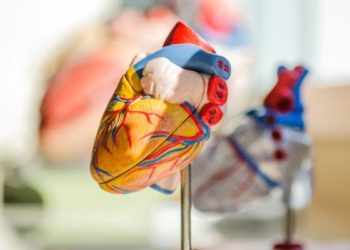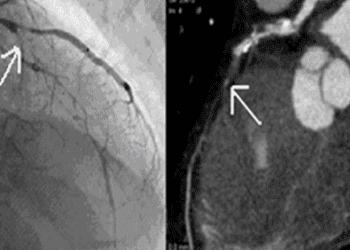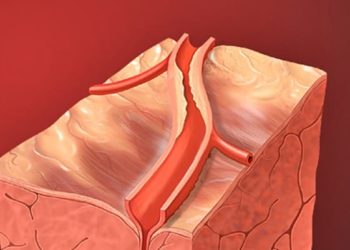Novel cardiovascular biomarkers associated with modest discrimination in early, noninvasive diagnosis of type 2 myocardial infarction
1. Biomarkers quantifying endothelial dysfunction, microvascular dysfunction, and/or hemodynamic stress provided modest diagnostic performance in the early discrimination of type 2 myocardial infarction (T2MI) from type 1 myocardial infarction (T1MI).
2. Given their limited clinical significance, clinical parameters and diagnostic investigations including coronary angiography and/or noninvasive functional or anatomic testing currently remain the only reliable means for timely identification of patients with T2MI.
Evidence Rating Level: 2 (Good)
Study Rundown: Myocardial infarction (MI) is one of the most common causes of death worldwide. Two different pathophysiological mechanisms underlie spontaneously occurring MI: T1MI, which arises via plaque rupture leading to coronary atherothrombosis and T2MI, which is due to a supply-demand mismatch from impaired systemic hemodynamics. Because treatments differ substantially, the rapid and accurate noninvasive discrimination of T2MI is essential. Unfortunately, this is a major unmet clinical need, as established biomarkers of cardiomyocyte injury, including high-sensitivity cardiac troponin (hs-cTn) levels, have only modest diagnostic discrimination. This multicenter prospective diagnostic study, APACE, sought to test the hypothesis that novel cardiovascular biomarkers quantifying different pathophysiological pathways involved in T2MI and/or T1MI may aid clinicians in the rapid discrimination of T2MI from T1MI. Among 5,887 eligible patients, 1,106 (18.8%) had an adjudicated final diagnosis of MI and of these, 246 patients (22.2%) had T2MI and 860 (77.8%) had T1MI. The study reported four major findings. First, most cardiovascular biomarkers evaluated had comparable concentrations between T2MI and T1MI and thus, were not helpful in their discrimination. Second, four novel biomarkers were higher in T2MI vs T1MI and showed modest promise for the early discrimination of T2MI (MR-proANP, CT-proET-1, midregional proadrenomedullin, and GDF 15). Third, cMyC concentrations, considered to quantify cardiomyocyte injury, were lower in T2MI vs T1MI and provided modest diagnostic accuracy, comparable with that provided by hs-cTnT and hscTnI. Lastly, while none of the tested cardiovascular biomarkers had significantly higher diagnostic discrimination, multivariable regression analysis suggested a possible additive value of MR-proANP to clinical variables. In summary, novel cardiovascular biomarkers provided modest diagnostic performance in the early detection of T2MI from T2MI. A limitation of this study was the number of patients in whom all (or most) novel biomarkers could be measured, as the cohort size was underpowered to allow for full comparison of diagnostic performance and assessment on the use of multiple biomarker combinations.
Click to read the study in JAMA Cardiology
Click to read an editorial in JAMA Cardiology
Relevant Reading: Cardiac troponin changes to distinguish type 1 and type 2 myocardial infarction and 180-day mortality risk
In-Depth [prospective cohort]: This international, multicenter prospective diagnostic study was conducted in 12 emergency departments in 5 countries (Switzerland, Spain, Italy, Poland, and Czech Republic) with patients presenting with acute chest discomfort. Exclusion criteria included patients with end-stage kidney failure receiving dialysis, patients presenting with ST-elevation MI (rare presentation in T2MI), and patients with an unclear final diagnosis despite elevated hs-cTn concentrations. The study sought to quantify the discrimination of hs-cTn T, hs-cTn I, as well as 17 novel biomarkers measured in subsets of consecutively enrolled patients against the reference standard (final adjudicated diagnosis), centrally adjudicated by two independent cardiologists. Among 5,887 patients, 1,106 (18.8%) had a final diagnosis of MI and of these, 860 patients (77.8%) had T1MI, and 246 (22.2%) had T2MI. When compared to patients with T1MI, patients with T2MI had lower concentrations of biomarkers indicative of cardiomyocyte injury including hs-cTnT (median [IQR], 30 [17-55] ng/L vs 58 [28-150] ng/L), hs-cTnI (23 [10-83] ng/L vs 115 [28-576] ng/L; P < .001), and cMyC (76 [38-189] ng/L vs 257 [75-876] ng/L; P < .001). However, T2MI patients had higher concentrations of biomarkers quantifying endothelial dysfunction, microvascular dysfunction, and/or hemodynamic stress (median [IQR] values: CT-proET-1, 97 [75-134] pmol/L vs 68 [55-91] pmol/L; midregional proadrenomedullin, 0.97 [0.67-1.51] pmol/L vs 0.72 [0.53-0.99] pmol/L; MR-proANP, 378 [207-491] pmol/L vs 152 [90-247] pmol/L; and GDF 15, 2.26 [1.44-4.35] vs 1.56 [1.02-2.19] ng/L; all P < .001). Discrimination for these biomarkers, as quantified by the area under the receiver operating characteristics curve, was modest (hs-cTnT, 0.67 [0.64-0.71]; hs-cTn I, 0.71 [0.67-0.74]; cMyC, 0.67 [0.61-0.73]; CT-proET-1, 0.73 [0.63-0.83]; midregional proadrenomedullin, 0.66 [0.60-0.73]; MR-proANP, 0.77 [0.68-0.87]; and GDF 15, 0.68 [0.58-0.79]; all 95% CI).
* cMyC = cardiac myosin-binding protein C, CT-proET-1 = C-terminal proendothelin 1, MR-proANP = midregional pro–A-type natriuretic peptide, GDF 15 = growth differentiation factor 15
Image: PD
©2021 2 Minute Medicine, Inc. All rights reserved. No works may be reproduced without expressed written consent from 2 Minute Medicine, Inc. Inquire about licensing here. No article should be construed as medical advice and is not intended as such by the authors or by 2 Minute Medicine, Inc.







